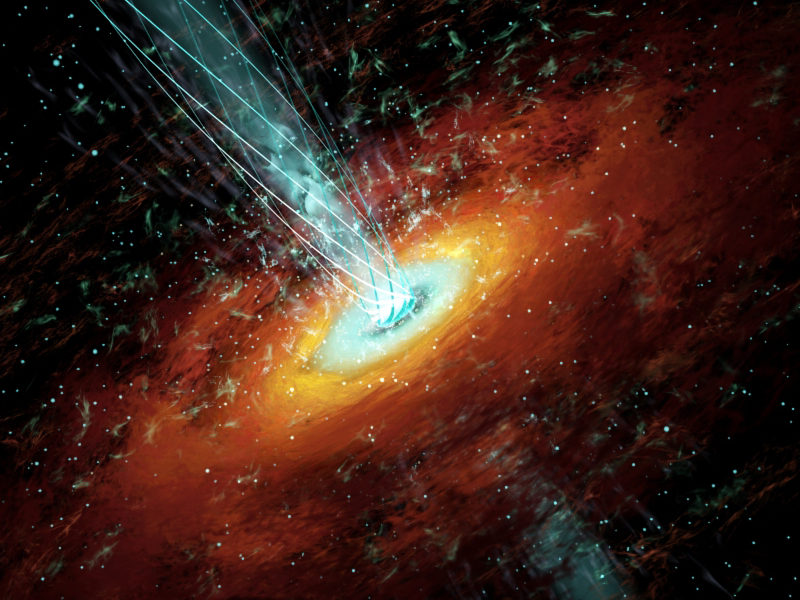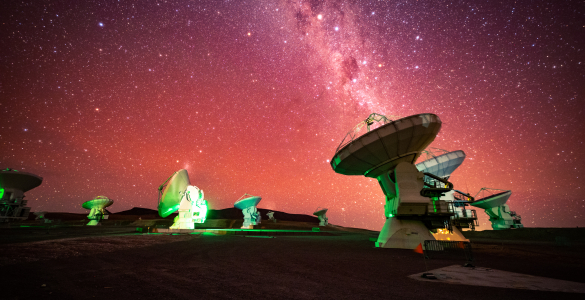Synopsis: Using data from ALMA, a team of astronomers studied the growth and evolution of bubbles of hot plasma produced by active quasarQuasarAn apparently small (at least to observers on Earth) yet immensely powerful cosmic object. Some quasars (quasi-stellar objects, or QSOs) are strong radio sources. Radio-emitting quasars were the first to be discovered. These are some of the most distant objects in the Universe, and are believed to be fueled by supermassive black holes residing in ancient galaxies. HE 0515-4414. The bubble was analyzed by observing its effect on light from the cosmic microwave background. It is the first time this method has been used to directly study outflows from quasars.
Cosmic microwave background radiationCosmic Microwave Background RadiationRadiation left over from the Big Bang. Because of the expansion of the Universe, the radiation is detected in the microwave portion of the spectrum (300 MHz [100 cm] to 300 GHz [0.1 cm]), and has a temperature of only 2.7 K (Kelvin) (or -270.45°C). is the first light in the cosmos. The light we see began its journey when the universe was just 380,000 years old, when the temperature of the universe had finally dropped to the point where the primordial plasma of electrons and protons cooled enough to form transparent hydrogen gas. At first, the cosmic background was a nearly perfect blackbody spectrum. A blackbody spectrum is the spectrumSpectrumA plot or distribution of light intensity at different frequencies and wavelengths. of light caused by the temperature of an object. Sunlight, for example, is also a blackbody spectrum. Shortly after it first appeared, the cosmic blackbody was an orange glow, but during its 13.7 billion year journey the expansion of the universeUniverseSimilar to the cosmos, this term that refers to all of space and everything that is contained within it. shifted it to infrared and then microwave radiation. We now see this background as a faint glow of microwave light coming from all directions.
The cosmic background is still a blackbody, but not a perfect one. There are small fluctuations in the background. Regions that are a bit warmer than average, and regions that are slightly cooler. Most of these fluctuations are due to variations in the early universe. Slightly warmer regions expanded to fill the vast voids between galaxies, while slightly cooler regions condensed into galaxies and clusters of galaxies.
But some of these fluctuations are due to the tremendously long journey the light took to reach us. While traveling for billions of years, the light of the cosmic background passed through all the gas, dust and plasma between us and its source. Some of the light was absorbed. Some lost energy by scattering and now appears cooler than it would otherwise. But some of it gained energy, making the cosmic background appear warmer than it should.
This warming process is known as the Sunyaev–Zel’dovich effect (or SZ effect). When low energy photons from the cosmic microwave background pass through a region of hot plasma, they can collide with fast-moving electrons. The photons are then scattered with a great deal of energy. So the cosmic light leaves the region warmer and brighter – leaving a “hole” in the background at low frequencies, corresponding to lower photon energies. By looking for temperature fluctuations in the cosmic background, astronomers can study regions of hot plasma.
In a recent paper published in the Monthly Notices of the Royal Astronomical Society, a team of researchers used the SZ effect to study bubbles of hot plasma near distant quasars. Quasars are bright radio beacons in the sky. They are powered by supermassive black holes in the hearts of galaxies. As the black holes consume matter near them, they radiate tremendous energy. They are often more than 100 times brighter than the galaxy in which they live. This can create a quasar wind of ionized gas that streams away from the galaxy, similar to the way our Sun creates a solar wind. When the quasar wind collides with the diffuse and cool gas of intergalactic space, it can create bubbles of hot plasma.
Quasars aren’t as distant as the cosmic microwave background, but they are still billions of light-yearsLight-yearsThe distance that light travels in one year in a vacuum. One light year is equivalent to about six trillion miles. away. That means any light given off by the plasma bubbles is much too faint to be observed directly. But they can be studied through the SZ effect. In order to do that, however, you need to capture high-resolution images of the microwave background. This is where the Atacama Large Millimeter/submillimeter Array (ALMA) comes in. Located high in the Andes of northern Chile, ALMA can capture microwave images at a resolution similar to visible light images captured by the Hubble space telescope. Just as the Hubble can show us beautiful images of distant nebulae, ALMA can capture images of hot plasma bubbles.
Using data from ALMA, the astronomers detected a bubble near the quasar HE 0515-4414. This is a hyperluminous quasar, meaning that it is extremely bright and active. But surprisingly when they used their data to measure the quasar wind, they found it was smaller than anticipated. The quasar wind is only 0.01% of the total luminosityLuminosityThe amount of energy that a star emits per unit time. It is independent of distance or how bright or dim the star appears from Earth. It is measured in Watts (Joules/seconds) and is often given in terms relative to our Sun, L⊙ (about 3.846×10^26 W). of the quasar. Theoretical models predicted that the quasar wind should be much stronger. It seems that while quasars can create hot bubbles of plasma around a galaxy, the process isn’t particularly efficient.
The scale of the bubble also told them it formed over a period of about 100 million years, and it will take about 600 million years to cool down. Those time scales are long enough that hot plasma bubbles could interact with cooler material in the galaxy to influence star production and the evolution of the galaxy.
Of course this is just the first hot plasma bubble to be observed, and it’s impossible to know if HE 0515-4414 is typical or a rare exception. So the search is on to find more bubble-blowing quasars.
Lacy, Mark, et al. “Direct detection of quasar feedback via the Sunyaev–Zeldovich effect.” Monthly Notices of the Royal Astronomical Society: Letters 483.1 (2018): L22-L27. (arxiv version)















